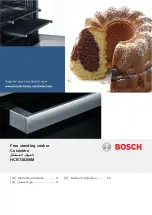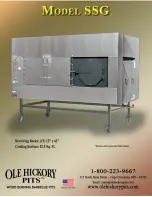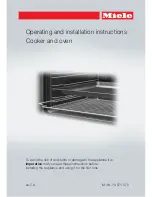
15
Cleaning agents
Observe the following information to ensure that the different
surfaces are not damaged by using the wrong type of cleaning
agent.
Do not
use
■
undiluted washing-up liquid or dishwasher detergent,
■
abrasive materials, scouring sponges,
■
aggressive cleaners such as oven spray or stain removers,
■
high-pressure cleaners or steam jet cleaners on the hob.
Clean the hob after each use. This will prevent spills from
burning onto the ceramic.
Only clean the hob when it has cooled down sufficiently.
Only use cleaning agents that are suitable for glass ceramic.
Follow the cleaning instructions on the packaging.
Ground-in dirt can be best removed with a glass scraper,
available from retailers. Please note the manufacturer's
instructions.
Only use
warm, soapy water
■
on the hob surround.
■
Do not use abrasive materials, scouring sponges,
■
aggressive cleaners such as oven spray or stain removers,
■
or glass scrapers.
Do not
use
■
any harsh or abrasive cleaning agents,
■
cleaning agents with a high concentration of alcohol,
■
hard scouring pads or sponges,
■
high-pressure cleaners or steam cleaners on the oven.
Wash new sponge cloths thoroughly before use.
Catalytic cooking compartment panels
The catalytic cooking compartment panels are coated with self-
cleaning enamel.
The surfaces clean themselves while the oven is in operation.
Larger splashes will only be removed after the oven has been
used several times.
The rear and side walls are covered with catalytic panelling.
Never clean these surfaces with oven cleaner. Slight
discolouration of the enamel does not affect self-cleaning.
Area
Cleaning agents
Appliance exterior
Hot soapy water:
Clean with a dish cloth and dry with a
soft cloth. Do not use glass cleaners or
glass scrapers.
Stainless steel
Hot soapy water:
Clean with a dish cloth and dry with a
soft cloth. Remove flecks of limescale,
grease, starch and albumin (e.g. egg
white) immediately. Corrosion can form
under such residues.
Special stainless steel cleaning prod-
ucts suitable for hot surfaces are availa-
ble from our after-sales service or from
specialist retailers. Apply a very thin layer
of the cleaning product with a soft cloth.
Aluminium and
plastic
Glass cleaner:
Clean with a soft cloth.
Enamel surfaces
(smooth surfaces)
To facilitate cleaning, you can switch on
the interior lighting and detach the appli-
ance door if necessary. Apply commer-
cially available washing-up liquid or a
vinegar solution with a soft, damp cloth
or chamois; dry with a soft cloth. Soften
baked-on food residues with a damp
cloth and detergent. We recommend
using oven-cleaning gel if the oven is
very dirty. This can be applied to the
affected area. Leave the cooking com-
partment open to dry after cleaning.
Self-cleaning sur-
faces (rough sur-
faces)
Please see the notes in section: Self-
cleaning surfaces
Door panels
Glass cleaner:
Clean with a soft cloth. Do not use a
glass scraper.
Glass cover for the
oven light
Hot soapy water:
Clean with a dish cloth.
Seal
Do not remove.
Hot soapy water:
Clean with a dish cloth. Do not scour.
Rails
Hot soapy water:
Soak and clean with a dish cloth or
brush.
Accessories
Hot soapy water:
Soak and clean with a dish cloth or
brush.
Area
Cleaning agents
















































